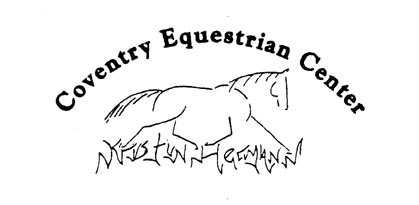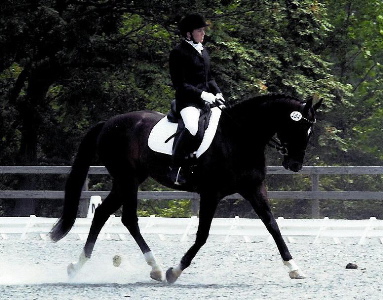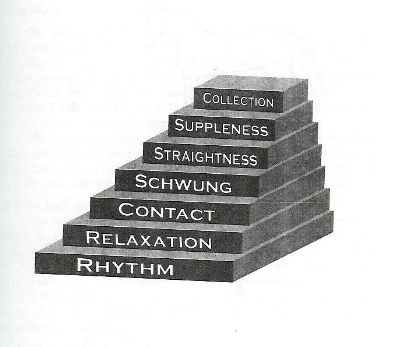|

Vol.: 1 Issue 4: December 2003

|
| Jerri, Cheryl B., Anita and Cheryl at the banquet. |
Coventry Equestrian Center cleans up at the WPDA Banquet,
and we arent talking dishes!
Everyone
probably knows by now about all the awards the Coventry riders won this year. We only thought we'd come home with two awards
and we were happy with that. But, when they kept announcing our names, people began looking at this joyous table that was
having so much fun. Here is our list of winners:
WPDA Walk Trot Adult Champion
Anita
and Midnight - 66.7%
WPDA Walk Trot Adult Reserve Champion
Cheryl
and Babe - 66.094%
WPDA Training Level Jr/Young Rider Reserve Champion
Brianne
and Arc - 66.390%
WPDA First Level Jr. Yr. Champion
Brianne
and Arc - 64.316%
WPDA Training Level Adult Champion
Jerri
and Bubba - 66.934%
WPDA First Level Adult Champion
Jerri
and Bubba - 61.443%
WPDA Training Level Certificate of Achievement
Jessie
and Gemini - 65.034%
Anita & Cheryl enjoying a relaxing moment at a Coventry
show.
Little did they know then that they're champions!
Now,
we are far from going to the Olympics, but these awards mean that we are the best in the Western PA Dressage Association.
Last year we won five awards, and as you know, Coventry riders have been winning for several years now.
Way
to go, ladies - all the best to you all for the next showing season!
In Training

I
am riding a First Level test - what do you think?
This
is a lovely picture of horse and rider looking so harmonious together. The rider is concentrating and the horse is attentive,
submissive and moving very nicely. The pair is turned out well - crisp and clean. It would not take much to make this a perfect
picture. The horse is a hair behind the rider's leg and note the poll is a bit dropped. The frame should be going up hill
a little more for First Level. Just let this horse come up to the poll and the hind end can step more underneath. This rider
could put her heel a touch down and slightly raise the outside rein. Her head is tilted slightly, but the horse is very straight.
She has a perfect elbow to bit connection. Her hands are low and quiet. Also, she is sitting quietly with her heel, hip, shoulder
and ear in alignment. You can see that the horse's tail is swinging and this horse is coming through, or stepping under
the rider's seat. These are all the basic qualities a horse and rider need to advance. This is the best picture I have seen
in a long time. However, despite the minute criticisms, even Olympic rider Klaus Balkenhol said in a recent article that perfection
will never be achieved with dressage. Also, I just happen to know that this pair won every 1st Level class they
entered this fall at Harlansburg. Congratulations!
Note:
this horse does not even have a hoof on the ground!
Learning how to ride?
Here is a quote from Kyra Kirkland (Olympic rider/trainer) in Dressage Today. "It takes 5,000 repetitions
to break an old automatic pattern, and another 100,000 repititions to make a new habit."
Apparently, this information is from a study that was done in Japan. So, remember to take those riding lessons
in order to practice new habits...Another quote: "Perfect practice makes perfect". Not "practice makes perfect", because
you may be practising wrong!
|
 |
|
|
|
 |
 |
 |

Taken from Walter Zettis book,
Dressage in Harmony
In
the November issue of In Stride, we wrote about the Training Scale. In that version, the fourth Training Scale says
"Impulsion" and the one above says "Schwung". Hmmm, lets go to our "Glossary of Dressage Judging Terms" and see what
it says. So, maybe since Americans have adopted the German Scale as their method for training horses, I think it is now fashionable
to say German words such as schwung.
Impulsion: Thrust.
"Releasing of energy stored by engagement. In dressage, impulsion is associated with a phrase of suspension such as exists
in trot and canter, but which does not exist in walk. Therefore, impulsion is not applicable to the walk." And, might
I add what our Glossary goes on to say just so you are not confused? (I am being sarcastic.) "Note: It may be enlightening
to compare the original French with the later English translation of the FEI score sheets under "Impulsion". The English translation
of the French reads, "The desire to move forward", whereas what the French actually says is "the desire to carry itself forward".'
Obviously,
Impulsion is something your horse acquires in Second Level, because it is stored energy of engagement. Think of that lift
you see horses have when they trot. I have called this "suspension. Well, I guess it is actually impulsion. Many of us think
of impulsion as going forward. Forward is forward, and you cannot have impulsion, or pushing power without first going forward.
Schwung
(Borrowed from the German)
"The condition in which the energy created by the hind legs is transmitted through a swinging
back and manifested in the horse's elastic, whole-body movement. See Swinging Back." Okay, let's see what the Americans say.
Swinging Back
"The way in which the horse's trunk muscles function with springy tension rather than rigidity
or slackness - which creates the impression that the horse's back swings and allows the energy produced by the hind legs to
be efficiently transmitted forward through the horse."
Oh
boy, I can see that I went overboard bringing you this information. No wonder no one reads this stuff! There is also an explanation
for Swing, Swinging, and Swinging Head. As I say, let the horse's tail swing not the horse's head. That, we will use for another
edition. So, simply just remember "Relaxed, Rhythmic and Round" (the three Rs) and you will be on your way.
Once you get to the higher steps on the Training Scale, you should know what you are doing. Impulsion, Schwung, straightness
(or suppleness according to Zetti) then the completed step is Collection. Oh, I just noticed Walter has 7 steps and, the Training
Scale in the other version has 6 steps. Thank God, the Training Scale is not listed in the "Glossary of Judges Terms", cause
we'd have to write an encyclopedia. After all that explanation, I just read an article in Dressage Today and it says
that schwung translates to mean Impulsion. That would have been simpler.
The
USDF Directory is a big source of information in a little package. This tiny booklet lists all the USDF shows,
awards, dressage protocol, and copies of the tests. To order yourself a 2004 edition log onto www.usdf.org.
Looking for Creative Ways to Change Direction in the Arena?
The following graphic from Walter Zetti's book, Dressage in Harmony shows you several ways to change
direction. Basically, you can ride across the diagonal, use the short diagonal, or to ride to the centerline then go straight.
This is challenging because you really have to know if you have the horse on the outside rein to go straight. I recommend
everyone practice this at the walk, then trot and canter and see how the communication between you and your horse improves.
If you do opt to do this at the canter, just stay tracking in the same direction. You do not have to change direction. And,
remember to turn your horse's outside shoulder into the direction you want to go, not just his nose! Happy and warm riding!
|
 |
|
|
|



